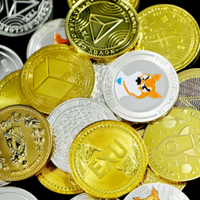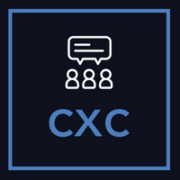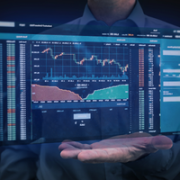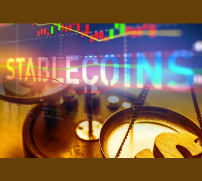Non-fungible Tokens: bubble or future?
| 29-11-2021 | Carlo de Meijer | treasuryXL | LinkedIn
A new phenomenon in the blockchain world are so-called NFTs or non-fungible tokens. Although NFTs have been around for some years, the market for digital art pieces, commemorative items, and other assets that now reside in blockchain ecosystems has exploded this year.
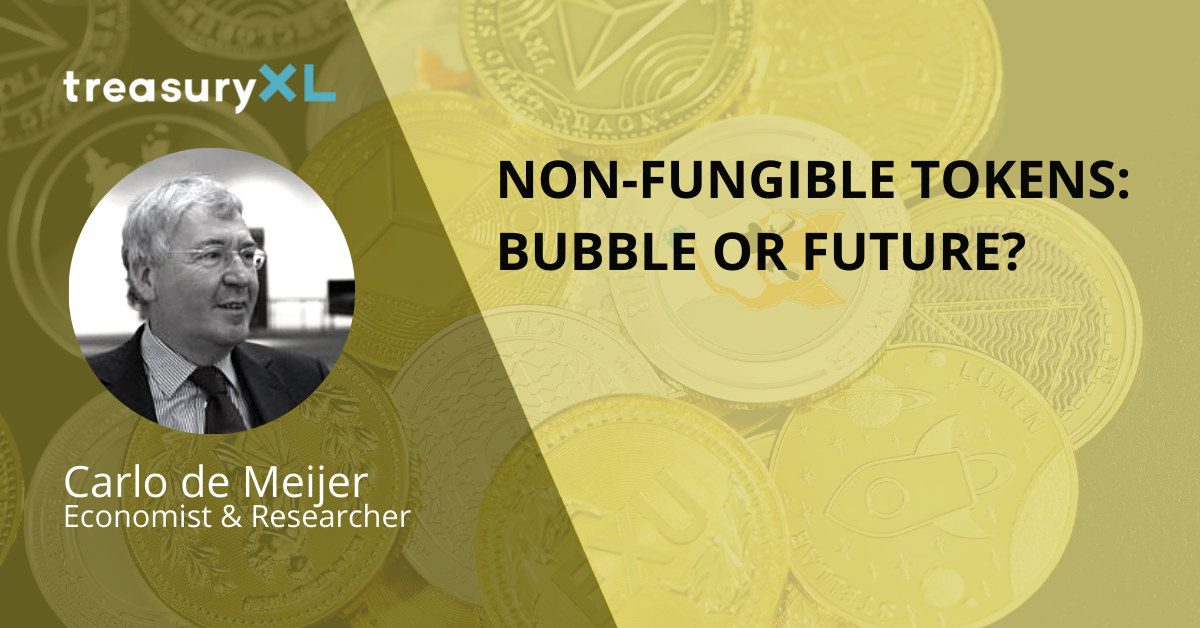
The NFT market got an enormous boost after Christie’s auction house sold a digital artwork last March titled “Everydays: The First 5,000 Days” made by digital artist Beeple for an astronomic $69,4 million. And there have been more of these exorbitant transactions. This triggered the NFTs market to grow exponentially, thereby gaining profound attention from various players from mainstream companies to retail and institutional investors.
Many are still struggling with the NFT phenomenon. While some see NFTs as a bubble, comparing it with the tulip mania in the 17th century, thereby debating over how long the NFT trend would last, others believe NFTs are here to stay and see it as the next investment theme.
In this blog, I will go into more detail related to the world of NFTs, what they are, where they could be used and what they may bring. But above all what are the risks and challenges associated with this new phenomenon.
What are NFTs?
NFTs, which stands for non-fungible token, are unique or distinct digital assets that cannot be replaced. Broadly speaking, they’re a one-of-a-kind digital asset. They have distinct properties, and can’t be changed with other assets. They are digital files that can carry any form of digital content (and can even contain access to physical content) from art to video to music.
NFTs rely on blockchain and cryptocurrencies to keep track of digital ownership and create scarcity to ensure they cannot be identically reproduced. NFTs enable to verify the authenticity of a digital artwork.
NFTs are not cryptocurrencies
NFTs are a type of asset which can be bought with cryptocurrencies. Both are tokens that are key elements in the world of blockchain. While both NFTs and cryptocurrencies use the same blockchain technology, they however differ in their attributes.
Cryptocurrencies use fungible tokens, meaning they can be traded or exchanged for one another. They are accessible in various forms and are utilized for various reasons. Every token is exactly the same and equal (represent the same amount of value). Crypto’s fungibility makes it a trusted means of conducting transactions on the blockchain.
A non-fungible token is different from notable cryptocurrencies in terms of fungibility. With NFTs, every token is different and unique. Each has a digital signature that makes it impossible for NFTs to be exchanged for or equal to one another (hence, non-fungible). If a person were to receive two NFTs, they would not represent the same piece of digital content, even if they were both exact copies of the same digital file.
What Are NFTs Used For?
NFTs are considered beneficial in a wide variety of blockchain use cases They can be literally anything digital such as art, fashion, licenses and certifications, collectibles, sports, etc.
NFTs are nowadays increasingly used in contemporary art auctions, including images, animation or even tweets. Non-fungible tokens also have made their way into real life applications beyond digital art and collectibles, such as music clips, videos, games, or even a ticket to an event, such as a movie or a sport game, that took place at a specific time. But also for domain names, virtual land and real estate.
An upcoming use case for NTFs recently is photography. Photography and prints have been particularly successful in this new online environment. Photographers are increasingly finding a new market for their work with NFTs.
An interesting new use case are political NFTs. In the US a Democrat-backed group, named Front Row, is planning the launch of a political NFT marketplace, that will be exclusively used for Democratic party campaigns and causes.
How does the NFT market work?
But how does the NTF market work? How can they be created and traded?
Creation of NFTs
Artists who want to create an NFT of one of their digital artworks will have to use one of the NFT platforms or NFT marketplaces. An NFT is created by ‘minting’ a digital asset (whatever it may be) on a blockchain. For that a digital wallet is needed with cryptocurrencies that allows you to store NFTs and cryptocurrencies.
Though there are more blockchains supporting different cryptocurrencies that can host NFTs, most major digital transactions are taking place on Ethereum. Ethereum’s MetaMask is such a wallet that is mostly used in the NFT market. This wallet can be downloaded from the App Store or via chrome extension.
Artists will need to purchase at least a fractional amount of Ether for so-called ‘gas fees’. This will enable them to cover the costs associated with minting your NFT, which places it on the Ethereum blockchain, and listing it for sale.
When adding an NFT to the Ethereum blockchain, a smart contract is added to the blockchain containing a set of actions and certain conditions to meet. They can be coded to detail the limitations on the use of an NFT. Once the conditions are met, the action takes place (such as providing a digital file to a buyer), and the blockchain is updated with this transaction.
Subsequently, the NFT creator has the privilege of putting up the NFT for sale on a marketplace. At the same time, NFT creators could associate the NFTs with a royalty agreement to receive added compensation with every sale.
NFTs can be sold or bought in the digital market via NFT market places.
NFT selling
In order to connect with NFT marketplaces and authenticate their identity, to access these market, they are required to have a digital wallet to streamline this process. If one wants to sell it or trade NFTs, it depends on the platform and whether he can send it to other platforms or only keep it on that platform. Even if one is just selling an NFT, one still needs to pay a transaction fee in ETH gas, which is a denomination of the token called Gwei (one billionth of ETH).
The new owner of an NFT would receive possession of the NFT through a smart contract. NFT sellers will thereby need to ensure that smart contracts clearly outline the rights that are being assigned as part of the NFT. In most cases, the NFT holder is simply obtaining a non-exclusive license to the underlying intellectual property rights of an asset and only for non-commercial purposes.
NFT buying
How you buy an NFT depends on the type of NFT you want to buy and the platform you are using. Most NFTs are purchased with a cryptocurrency and some with fiat currency. For buying NFTs, you must have a crypto wallet that allows you to store NFTs and cryptocurrencies.
Before purchasing any NFT, one first needs to purchase some cryptocurrency. This depends on what currencies your NFT provider accepts. Most likely this will be ETH, Ethereum’s native token. They can be purchased by using a credit card on almost any digital exchange from Coinbase, Binance, eToro to Coinbase and even Paypal now. Most exchanges charge at least a percentage of your transaction when you buy crypto.
After this one will be able to move it from the exchange to their crypto wallet of choice. From that on it is simple on most platforms to connect the wallet. Once the wallet had been connected, users can begin browsing the market and placing bids.
Each user’s wallet address thereby acts as a passport and lets users interact with certain NFT platforms. And if one later decide to use NFT marketplaces outside of Ethereum, one will still be able to swap ETH tokens for alternative blockchain tokens.
NFT Market places
NFTs allow digital works to at least be traded via NFT marketplaces. On these marketplaces NFTs can be created, bought or sold. Most marketplaces hold auctions where users can submit a bid for an NFT they wish to purchase. Buying an NFT from the primary marketplace increases potential resale value directly after the product goes on sale. That especially goes for a high demand NFT immediately after their release. On the other hand, one of the main issues with buying an NFT from a primary marketplace is it is hard to estimate the demand for the art. On the secondary marketplace, however, users are able compare purchases to previous sales.
Most popular NFT marketplaces
Currently there are several NFT marketplaces and each marketplace sell different types of NFT. The most popular and largest ones include: OpenSea, Rarible and Foundation NFT. Other interesting platforms have names like CryptoSlam, AtomicAssets, SuperRare, Nifty Gateway and NBA Top Shot. Most of these marketplaces are still hosted on Ethereum’s blockchain, thereby acting as Ethereum’s dApps.
OpenSea is a marketplace for NFTs which operates on Ethereum trading rare digital items and collectibles. It hosts a variety of digital collectibles, from video game items to digital artwork. Using OpenSea, users can interact with the network to browse NFT collections to exchange NFTs for cryptocurrency. One can also sort pieces by sales volume to discover new artists.
Rarible s a so-called ‘democratic’, open marketplace that allows artists and creators to issue and sell NFTs. RARI tokens issued on the platform enable holders to weigh in on features like fees and community rules.
On the Foundation NFT marketplace artists must receive “upvotes” or an invitation from fellow creators to post their art. The community’s exclusivity and cost of entry – artists must also purchase “gas” to mint NFTs – means it may boast higher-calibre artwork.
An interesting newcomer on the NFT market is Coinbase. The cryptocurrency exchange, aims to launch a marketplace that lets users mint, collect and trade NFTs. Users can sign up to a waitlist for early access to the feature. Its marketplace, to be named Coinbase NFT, would include ‘social features’ and tap into the so-called creator economy (a term used to describe the world of people who make money posting videos and other content online).
What may NFTs bring?
NFTs provide a number of advantages to both content creators, sellers and buyers, depending on the platform they are created on. With NFTs in Ethereum, the smart contract is automatic: The code in the smart contract cannot be changed once it’s added to the blockchain, and the transaction cannot be changed once the criteria have been met and verified. This provides security to both creators and buyers.
For the creator
Blockchain technology and NFTs afford artists and content creators a unique opportunity to monetize their wares. For example, artists no longer have to rely on galleries or auction houses to sell their art. They can sell it directly to the consumer as an NFT, which also lets them keep more of the profits.
Typically, most art pieces are physically sorted, which exposes them to the risk of being stolen or duplicated. NFTs may eliminate these shortcomings to certain extent by allowing artists to keep the records of the actual copy on the blockchain network. On top NFTs create an ecosystem where artists can authenticate the actual ownership of their work by recording the metadata on-chain.
Most websites where NFTs are sold also allow content creators to add a royalty system to the subsequent selling of their content. Doing this they may receive a percentage of sales whenever their art is sold to a new owner. Importantly, the artist benefits every single time their NFT changes hands. This is seen as an attractive feature as artists generally do not receive future proceeds after their art is first sold.
For the collector
NFTs allow for proof of ownership in the digital world for the collector. Before the invention of NFTs, there was no way to prove the ownership or authenticity of digital artworks or collectibles. With NFTs the investor has true ownership of the non-fungible token they purchase. When a digital asset is tokenized this creates value as it is possible to prove its authenticity and ownership, which also means it can be bought and sold many times over.
With NFTs, a copy can be verified with the use of a unique identifier included in the NFT, and the history of ownership for that copy can be maintained. Because it has a unique identifier, and there’s a record of the work on the blockchain, it’s easy to track.
Next to that due to blockchain technology and NFTs, the principle of ‘scarcity’ now also exists
in the digital world. This because each NFT is rare, unique and indivisible. For a collector, the intrinsic value associated with the purchase of an NFT is supporting an artist whose work they admire.
It also give access to decentralised finance (DeFi) NFT services. Some NFT projects such as Hoard marketplace are providing DeFi services which allows users to buy, sell, loan or rent NFTs. The platform empowers developers with tools to integrate digital art, in-game items and domain names with the Ethereum blockchain.
Other potential benefits of this NFT eco system are growth prospects and value preservation where artist can preserve their art and yield income. The growth prospects of NFTs are significant and present more opportunities for creatives and investors to join the market. The NFT market is firmly growing, which means most NFTs could only become more valuable and innovative as time goes on.
And there are the utility benefits. NFTs enable businesses and individuals to acquire and protect value in real-world and virtual objects. When one owns an NFT on the blockchain, one has the ability to flip it, or sell it on the secondary market, for profit.
The downside of NFTs
While the advantages/benefits of NFTs clearly paint a promising picture for their future, these markets are also confronted with various challenges and risks that one should consider before deciding to enter the space.
First of all there is the market risk. The market for NFTs such as digital art and collectibles is booming — but that doesn’t mean they are a safe investment. Investing in NFTs comes with its own unique set of risks. Their future is uncertain, and we don’t yet have a lot of history to judge their performance. When investing in NFTs one should be aware of volatility, illiquidity, and fraud in the nascent market.
Though investing in art is often a subjective act, there is the risk of losing its value. The NFT market suffers from massive volatility, in part because there aren’t any mechanisms in place yet to help people price these digital assets.
When it comes to liquidity of NFTs every seller needs to find a buyer who’s willing to pay a certain price for a particular, one-of-a-kind item. That can put collectors in a difficult position if they have spent a lot of money on a ‘Top Shot‘ moment and the market begins to tank.
Another risk refers to the uncertainty in determining the value of NFTs. The valuation of NFTs depends considerably on the authenticity, creativity, and the perception of owners and buyers. An NFT’s value is based largely on what someone else is willing to pay for it, thereby leading to fluctuations. Therefore, demand will drive the price rather than fundamental, technical or economic indicators.
And there is the risk related to intellectual property issues. Someone who buys an NFT, only gets the right to use the NFT rather than intellectual property rights. It is therefore important to consider the ownership rights of an individual to a particular NFT in the metadata of the underlying smart contract, such as copyrights, trademarks, patents, moral rights, and the right to publicity.
The growing NFT market is also attracting cybercriminals resulting in various risks of fraud, cybersecurity and hacks. There have been a few instances of fake websites, where NFTs hosted on the platform have disappeared and faced copyright and trade infringements.
Some artists have also fallen victim to impersonators who have listed and sold their work without their permission. And those who own an NFT do not necessarily own the original version of the digital content.
Another risk related to cybersecurity and fraud include copyright theft, replication of popular NFTs or fake airdrops, and NFT giveaways. And there is the risk of smart contracts being attacked by hackers and the challenges of NFT maintenance. This is seen as a main concern in the NFT landscape presently. As a result people can end up buying the fake NFT tokens, which practically do not have any value as an asset.
In addition, NFTs are also associated with jurisdictional challenges as there is no specific precedent for regulating NFTs. Decentralized peer-to-peer transactions on blockchain-based NFT platforms without any monitoring authority can lead to AML and CFT challenges. As NFT can challenge the conventional FATF standard, regulations and intermediate supervision become necessary for these platforms.
Challenges
An there are the various challenges NFTs may be confronted, that could limit their adoption. Some of these challenges are more fundamental.
One of the most fundamental challenge for this NTF market is how these tokens will have to be fused into an ill-suited legal framework. The lack of regulation creates a lot of pitfalls in NFT adoption. There is the confusion of how NTFs should be classified and thus regulatory treated. As a security or something else. NFT does not have a specific definition and can describe a wide variety of assets. They are unique, not interchangeable, and not fungible. With the increasing variety and number of NFTs, it is difficult to find a solid ground for compliance in NFTs. As of now, many of the existing laws pertaining to NFT are stuck on finding the ideal definition for NFTs. Various countries like Japan, UK, US and the EU have different approaches for the classification of NFTs.
Next to regulatory challenges there is the lack of uniform, universal infrastructure for NFTs that may limit their adoption. For instance the verification processes for creators and NFT listings aren’t consistent across platforms – some are more stringent than others.
Accessibility to NFTs can be a significant barrier for new entrants to the NFT market. While NFT marketplaces are user-friendly, content creators must pay fees for the creation and upkeep of the NFT. These fees are usually required to be paid with a cryptocurrency in a digital wallet. The NFT marketplaces are also only popular for certain types of digital content; currently, for example, there are very few writers who sell their work as NFTs.
Environmental effect
Another pain point of using NFTs is the effect the cryptocurrency industry has on the environment. The current mining practices for the most popular cryptocurrencies use proof-of work techniques, which require a vast amount of energy from powerful computers.
The way forward: bubble or future
The NFT markets are booming. And every day new use case are entering the NFT market attracted by the various benefits and the incredible profits that can be made.
But the risks and challenges this market is confronted with will ask for regulatory intervention. The importance of reflecting on the legal and regulatory NFT risks is clearly evident. As this NTF market continues to grow and expand into different use cases, this raises the importance of having an international regulatory body of Non-fungible tokens for its better regulation and legalization. The outcome could have a great impact and will be decisive for the future of NTFs.
It is however still uncertain how that will proceed.
Carlo de Meijer
Economist and researcher

